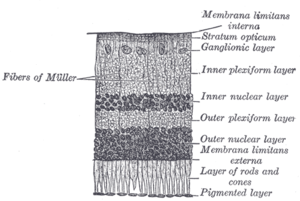X-linked congenital stationary night blindness
| X-linked congenital stationary night blindness | |
|---|---|
 |
|
| Malfunction in transmission from the photoreceptors in the outer nuclear layer to bipolar cells in the inner nuclear layer underlies CSNB. | |
| Classification and external resources | |
| Specialty | ophthalmology |
| ICD-10 | H53.6 |
| ICD-9-CM | 368.61 |
| OMIM | 310500 300071 |
| DiseasesDB | 32689 |
| MedlinePlus | 003039 |
X-linked congenital stationary night blindness (CSNB) is a rare X-linked non-progressive retinal disorder. It has two forms, complete, also known as type-1 (CSNB1), and incomplete, also known as type-2 (CSNB2), depending on severity. In the complete form (CSNB1), there is no measurable rod cell response to light, whereas this response is measurable in the incomplete form. Patients with this disorder have difficulty adapting to low light situations due to impaired photoreceptor transmission. These patients also often have reduced visual acuity, myopia, nystagmus, and strabismus. CSNB1 is caused by mutations in the gene NYX, which encodes a protein involved in retinal synapse formation or synaptic transmission. CSNB2 is caused by mutations in the gene CACNA1F, which encodes a voltage-gated calcium channel CaV1.4.
Not all Congenital Stationary Night Blindness (CSNB) are inherited in X-linked pattern. There are also dominant and recessive inheritance patterns for CSNB.
The X-linked varieties of congenital stationary night blindness (CSNB) can be differentiated from the autosomal forms by the presence of myopia, which is typically absent in the autosomal forms. Patients with CSNB often have impaired night vision, myopia, reduced visual acuity, strabismus, and nystagmus. Individuals with the complete form of CSNB (CSNB1) have highly impaired rod sensitivity (reduced ~300x) as well as cone dysfunction. Patients with the incomplete form can present with either myopia or hyperopia.
...
Wikipedia
